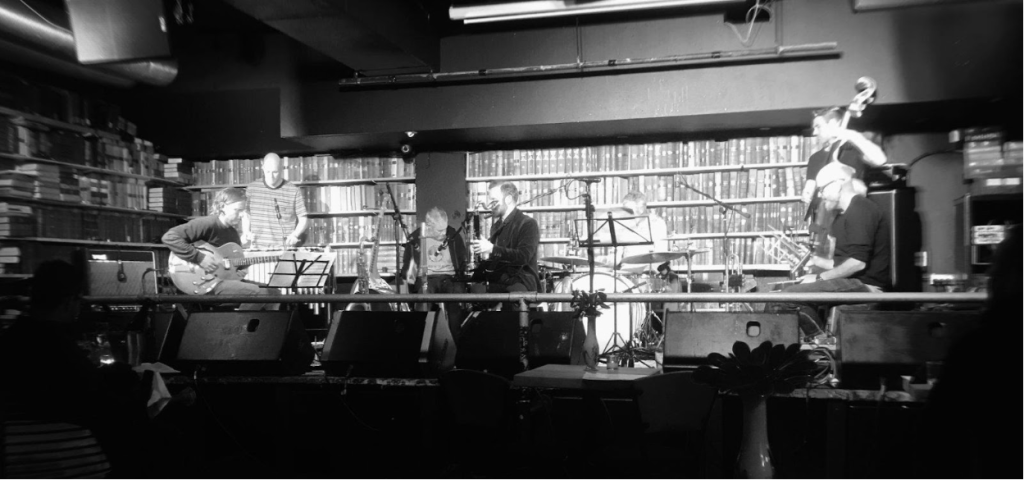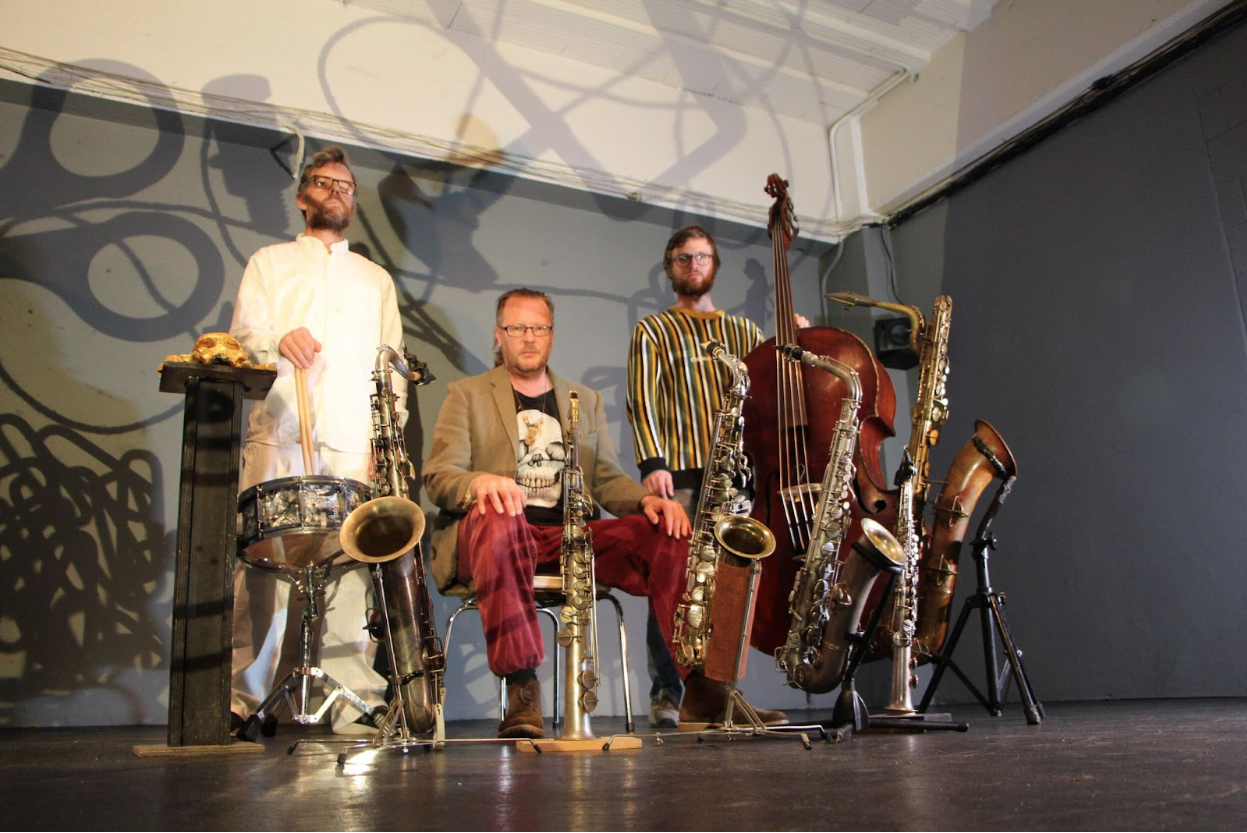The enormous impact of COVID-19 on music in Aotearoa is obvious. Concerts often can’t go ahead, and audiences often don’t want to go out. During lockdowns, musicians couldn’t even get together to play just for the sake of it. For jazz musicians, who place so much value on the live experience, the moment of creation, these are especially difficult times – but also times of unique opportunities.
My car, a 2001 Toyota Corolla fondly dubbed “Matilda”, is covered in lichen. Not exactly, but there’s a lot of it: it grows in the gaps along the doors and door handles, along the roof, the wing mirrors, around the headlights, anywhere there’s a crack. It’s tenacious stuff, surviving weeks of hot, rainless summer, carwashes, once-in-one hundred year storms, you name it. When I look at it, I always feel a little glow of admiration. Right now, it reminds me of the jazz scene in Aotearoa.
Jazz in Aotearoa has always existed in the cracks. Jazz historian Aleisha Ward notes this has especially been the case since the decline of TV and radio bands, dance bands and cabarets, active in various guises from the 1920s through to the 1970s: “Then as now however,” she says, “most musicians also had other gigs and hustles either in or outside of the music industry to make ends meet.” This will be a familiar concept to the astute jazz fan, who might spot their favourite musicians performing in a wedding band, playing straight ahead jazz in a bar, and freely improvising for koha at an underground venue, all in the same week. Nevertheless, Ward points out, jazz musicians in the first half-century of the music’s history in Aotearoa were certainly able to support their more creative endeavours through commercial opportunities. As these dried up, the last fifty-odd years have seen musicians relying much more heavily on public funding.
Aleisha Ward writes jazz history blogs at nzjazz.wordpress.com Twitter: @nzjazzhistory
As an author of dozens of funding applications, I can attest that jazz fits somewhat awkwardly in the current models. It doesn’t have the mass appeal to meet the criteria for organisations such as NZ On Air, yet its history as a popular music, its omnivorous assimilation of styles and genres, and the ephemeral nature of improvising makes it a dubious contender for art-music funding by certain gatekeepers (I was once told I would need to justify on a funding application why the jazz I was making, being an “American” art form, contributed to New Zealand music – something I’m sure has never been requested of artists making music in the European classical tradition). Recently, however, COVID has flipped the script on this dilemma: with recovery money being liberally splashed around, and a dearth of competition from popular local and overseas acts in Aotearoa’s venues, a number of exciting new ventures have launched.
Prolific multi-instrumentalist Jeff Henderson has released seven albums under his new label Kiwijahzz, with more in the pipeline. Grouped together as volumes under the title “Jazz From The Underground Nightclubs of Aotearoa”, they offer a snapshot of the bursts of creativity typical of the periods of “normality” between restrictions over the past two years.
Most of the albums were recorded at Tāmaki Makaurau/Auckland’s Wine Cellar, featuring Jeff’s trio “Trioglodyte” and various special guests. Henderson told me how hesitancy from many artists in more popular fields paved the way for a regular spot for this new outfit: “After that first lockdown, there was a good opportunity there I suppose, I think it was maybe Level 2…so venues here like the Wine Cellar were at half capacity… a lot of [performers] weren’t interested, a lot of the music isn’t sit-down music… it felt quite open for me to [propose] a monthly jazz residency.”
Henderson wasn’t especially concerned about the prospect of low audience numbers, which is an all-too-common reality for jazz musicians at the best of times. “I’d never really expect to get 50 people paying to come [laughs]... it was fine for the kind of music I play to book gigs and there was a lot of space and time to do it.” Furthermore, Wine Cellar was equipped with a high quality recording setup: “...everything was really well recorded to multitrack, so even if no one turned up… you still played and got a great recording.” I assumed this new tech was as a result of the New Zealand Music Commission’s venue infrastructure fund, but Henderson assured me that development had happened over some time – instead, Wine Cellar used the money to properly fit out air conditioning, a marked improvement in safety and comfort.
Such opportunity combined with the Wine Cellar’s fresh infrastructure has allowed this new music to thrive in a way that may not have been possible pre-COVID. Trioglodyte was even able to announce repeat shows on a couple of occasions when nothing was booked the following night, meaning they were able to experiment beyond the constraints of the one-off show, “doing the same set twice, having two different audiences, play with the format a bit.”
“The idea was to have the trio as the core band and each month invite some guests and… draw in a really wide range of people that wouldn’t normally play in a more jazz context, or people I hadn’t played with before…We ended up playing various jazz standards from different periods and little pop songs, if a Bruce Springsteen number came to mind we’d play that, you know?” Listening to Jazz from The Underground Nightclubs of Aotearoa, you can hear this unrestrained fun, especially in what one review calls the “deliriously wonky” versions of famous jazz standards. The music is exciting and immediate: it’s the heartbeat of the scene. You can hear in it the joy, the freedom, the in-your-face, sweaty, warts-and-all, closeness of a small club. It’s everything that a live gig should be. In capturing and releasing these shows, Henderson said he was emulating to an extent great traditional music labels such as Folkways and Ocora, making an archive of what he describes as a “part of the urban folk ecology.” “It’s like documentary snapshots of a time and place…The thing is to present the music faithfully, before trying to create a product for an audience.”
Tāmaki Makaurau spent a lot of time in lockdowns, which gave Henderson plenty of time to delve into more music for Kiwijahzz: “Now that it’s had 7 releases and there’s a couple more in the pipeline…it’s branching out, not necessarily focussed around my projects…I’ve been going through loads of archival recordings…trying to find different things and asking people for various recordings and kind of seeing what comes of that.” So much of daily life moved online during this time, and releasing and distributing music has been no exception. Henderson praises Bandcamp, an online music streaming and distribution service which hosts the Kiwijahzz releases and which (unlike many competitors) aims to properly remunerate artists. “Having this marvellous platform of Bandcamp, to release music on a digital channel…I would never release as much stuff if I had to pay for it… press a CD or vinyl or tape or whatever…. You can throw stuff up and still treat them like albums.”
 Devil’s Gate Outfit. From left: Daniel Beban, Cory Champion, Dave Donaldson, Blair Latham, Anthony Donaldson, Tom Callwood, Steve Roche.
Devil’s Gate Outfit. From left: Daniel Beban, Cory Champion, Dave Donaldson, Blair Latham, Anthony Donaldson, Tom Callwood, Steve Roche.
One highly anticipated release is that of the “Devil’s Gate Outfit”, a septet from Te Whanganui-a-Tara/Wellington that has wowed audiences during multiple residencies at popular venue Meow over the last two years. The ensemble originally formed to play the music of the celebrated saxophonist Neil Duncan, who sadly passed away in December 2021. After their initial recording just days before the first lockdown in March 2020, Duncan returned to his home in Australia, and between border closures and ill health couldn’t make it back for a planned reunion. Nevertheless, the band forged on with an astonishing run of shows, avoiding cancellations or postponements entirely. Drummer Anthony Donaldson told me the opportunity to perform so regularly at Meow was partly driven by the pandemic: “In the last two years we’ve done thirty gigs…We’ve got our band up and running really quite quickly, and in fact because of COVID in many ways that’s why we’ve done so well, because heaps of groups weren’t playing, hence we were able to get four different residencies.”
Donaldson told me he wasn’t at all concerned about the challenges of performing under the various restrictions. “I couldn’t care less, all I want to do is play. That’s all I want to do in my life!” – and a small group of diehard fans gave this energy back. “Everyone was starved for it, the audience we had…there were some people who turned up to every gig, believe it or not.” Having witnessed a number of these gigs myself, I can believe it. This level of dedication also gave the band a touchstone to the audience experience: “It was fascinating. They were able to…give us some real insight into how we were playing and what was happening, ‘cause they knew our music just about as well as we did!” One-third catchy, ear-worm melodies, one third deep rolling groove (supplied by bass, bass banjo, drums and a lot of percussion) and one third harmolodic, Ornette-Coleman inspired improvisation, the music is surely worth repeat listens: familiar yet changeable, satisfying yet surprising. A fifth residency is upcoming: jazz fans take note.
Kiwijahzz is on Bandcamp: https://kiwijahzz.bandcamp.com/
Look out next week for Part 2, in which we'll hear about the Jazz scene in Ōtautahi/Christchurch and Ōtepoti/Dunedin.
